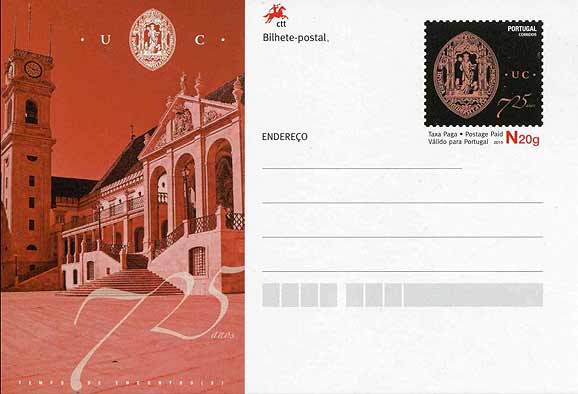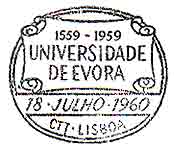The University of Coimbra


PORTUGAL,1972, a definitive focus on education at Coimbra, Scott 1124
PORTUGAL, 2007, the finalists for the 7 wonders of Portugal, Scott 2926e
In the 2007 Seven Wonders of Portugal contest, from an initial list of 793 entries 21 finalists were selected and commemorated on Portuguese stamps. The University of Coimbra, which, though founded in 1290, has some Jesuit connection, was one of the 21 finalists. The stamps were issued on three mini-sheets with seven stamps and a label on each sheet. The Coimbra stamp above shows the old section of the university with its clock tower, the Patio das Escolas or Royal Palace, and to their right the Via Latina, a wide balcony attached to the north face of the university palace.



PORTUGAL, 1972, bicentenary of the Pombalian Reform of the University
of Coimbra, Scott 1153-55
featuring Pombal, symbols of science, and the insignia of the university





PORTUGAL, 2014, Coimbra University is classified as Portugal's 16th
UNESCO World Heritage site, Scott 3644-3649

PORTUGAL, 22 June 2015, a postal card to commemorate the 750th anniversary
of Coimbra University
Two of Ignatius' first companions, Simon Rodriguez and Francis Xavier, came to Portugal in 1540 on their way to the Indies. Their preaching while in Portugal so impressed King John III that he wanted to keep them there. Ignatius and the king compromised: Francis went on to India, Rodriguez and some other Jesuits in 1542 opened in Coimbra a "college" endowed by the king. This "college" was at first a residence for Jesuits who studied at the University of Coimbra, especially those preparing to go to the Indies. No classes or academic instruction was given at this "college." By 1544 Jesuits had seven such residential colleges but the one at Coimbra was the largest and most financially stable; it opened in 1542 with a dozen students and by 1546 had about 100.
In 1547 King John created the Royal College of Arts and Humanities at Coimbra because Portuguese candidates to the university did not have any place prepare for higher studies, a college whose quality of education was recognized in other countries. This college was staffed with quality teachers of grammar, language, history, geography and mathematics, rhetoric, the humanities, and philosophy. Initially it functioned independently of the university, but it eventually became a faculty of the university and was confided to the direction of the Jesuits in 1555.
In 1561, it was decreed that no one could register in the university Faculty of Law without a certificate from this Jesuit College of the Arts. This effectively gave a monopoly on secondary education to the Jesuits, and gave them great influence within the university, influence that lasted until 1759 when Pombal banished the Jesuits from Portugal.

PORTUGAL, 1959, the university's 4th centenary, Scott 857-59, and the
FDI cancel
The Universidade do Espírito Santo at Évora opened under the Jesuits on 1 November 1559 and closed after 200 years when in 1759 they were expelled from Portugal by the Marquês de Pombal. It reopened after more than two more centuries in 1973 so that what Portugal celebrated in 1959 was the 400th year from the foundation of the university, not 400 years of university existence.
The Jesuit College and the Church of St. John the Evangelist, Funchal, Madeira
MADEIRA, 1989, the Jesuit college church of St. John the Evangelist, Scott 131The Jesuit College of Funchal (Colégio dos Jesuítas do Funchal) in the now autonomous region of Madeira, Portugal was established by a royal charter of King Sebastian, dated August 20, 1569. In 1599 the Jesuits constructed the large building of the college in the city center, and 1624 they began the construction of the Church of St. John the Evangelist which was competed around 1647, as part of the college complex. The dedication to St. John the Evangelist reflects the fact that lessons at the college began on 6 May 1570. On that date until 1960 the General Roman Calendar celebrated the feast of "St. John before the Latin Gate" commemorating the story of the apostle's suffering in Rome. Gilded carved altarpieces date from 1647-1660, frescoes on the ceiling date from the 17th and 18th centuries. The high altar is a masterpiece of Madeiran carving of the period. With the expulsion of the Jesuits in 1768, the college passed to secular hands and has since grown into the University of Madeira.
Santarém Cathedral
PORTUGAL, 2012, Santarém Cathedral from the Route of the Portuguese Cathedrals issue, Scott 3407In 1609, Duarte da Costa, son of Portugal's chief armorer, entered the Society of Jesus as a novice. Part of his inheritance was offered to finance the construction of a college for the Company of Jesus in Santarém, which opened its doors in 1621. In 1647, King João IV gave the company the estate of the ruined royal palace and appointed Mateus do Couto as architect. Construction of the church began in 1672 and was probably finished by 1711. The Jesuits were expelled in 1759 and their assets were confiscated. In 1780, Queen Mary I offered the Santarém building to the Patriarch of Lisbon for the Patriarchal Seminary. After the French invasions and the Civil War, the seminary was closed in 1834. It was restored by Cardinal Guilherme Henriques de Carvalho in 1853. On 16 July 1975 Pope Paul VI created the Diocese of Santarém and the church became a cathedral.
Jesuit Libraries in Portugal
PORTUGAL, 1996, the bicentenary of the National Library of Portugal, Scott 2086Portugal's national library was created by royal charter in 1796 and given the name Real Biblioteca Pública de Corte e do Reino, or Royal Public Library of the Court and Kingdom. It was officially opened to the public in May, 1797. The library was to be housed in the buildings of the former Royal Office of Censorship in Lisbon's Praça do Comércio (1771), and the collections of that office—more than 60,000 volumes confiscated from the suppressed Jesuit colleges and other institutions—were to be transferred to the new library.





